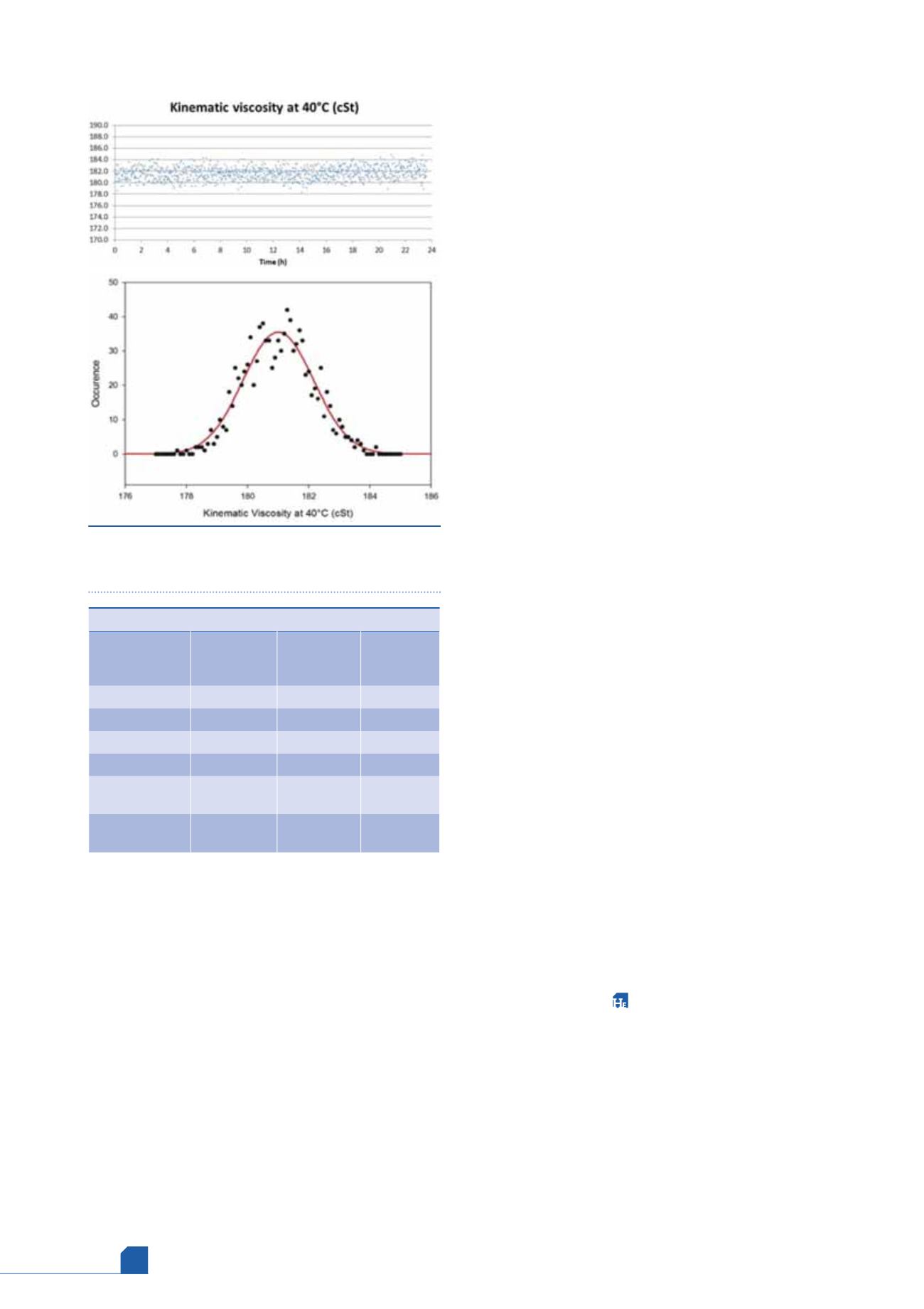
March
2017
HYDROCARBON
ENGINEERING
100
degrees above the reference temperature, the cooling cycle
is short. This new kinematic viscosity analyser has many
advantages, including low pricing.
Results
In this section, the tests that were performed on the
analyser to evaluate stability and analytical performance
are detailed, namely: accuracy, repeatability and
reproducibility.
Results on reference product
One must consider how other technologies that are used
to measure kinematic viscosity evaluate the repeatability
and accuracy. Most technologies rely on two separate
analysis, one for dynamic viscosity and one for density. This
means that the repeatability of the analyser needs to take
into account the error on both measurements. Often, only
the repeatability and accuracy data for dynamic viscosity
are published, as the error on density is considered low. For
the purpose of this study, it was decided to directly publish
the performance obtained for kinematic viscosity.
In order to evaluate repeatability, the analyser ran for
24 consecutive hours. The analyser directly calculated
real time kinematic viscosity. Figure 4 presents the
recording over 24 hours for kinematic viscosity using the
new analyser along with the statistical distribution.
These tests show that under repeatability conditions,
the standard deviation of the measurements made by the
analyser is 0.6% of the reading (for an expected viscosity of
182.6 centistokes [cSt], the standard deviation is 1.09 cSt).
The repeatability limit (i.e. the value less than or equal to
which the absolute difference between two test results
obtained under repeatability conditions may be expected
to be with a probability of 95%) is equal to 1.2% of the
reading (twice the standard deviation).
The heat exchanger at the inlet of the analyser ensures
that the measurement is made under repeatability
conditions at all times. This means that, for this specific
measurement, repeatability and reproducibility can be
considered as the same value. Hence, the reproducibility of
the analyser is set to be at 1.2% of reading.
The analyser is designed to operate around a specific
operating point (one target viscosity at a specific reference
temperature). The analyser is therefore calibrated in order
to ensure that at the operating point, the measurement is
as close to the viscosity of the reference product as
possible. Based on this, the reproducibility limit and
accuracy are considered to be identical, which gives an
accuracy of 1.2% for the measurement. Table 1 summarises
the results of the tests.
Conclusion
At the beginning of this article, the problems with online,
real time measurement of kinematic viscosity were
explained, and the main existing technology and its
weaknesses were presented.
In order to solve the issues raised in the previous
sections, the article outlined how a technology used to
measure dynamic viscosity was adapted to also measure
density and kinematic viscosity. This technology was also
adapted into a new analyser to measure kinematic viscosity
at reference temperature.
The performance of this new analyser can be correlated
to the ASTM D445, which corresponds to the needs of
most customers. This new analyser therefore brings a new
solution to customers to carry out a kinematic viscosity
measurement of the same sample for both dynamic
viscosity and density.
References
1. HALLIKAINEN, K. E., ‘Viscosmetry’, Instruments and Control System,
(November 1972).
2. ASTM D445-15a (2005): ‘Standard test method for kinematic
viscosity of transparence and opaque liquids (and calculation of
dynamic viscosity)’.
3. FR2 911 188, Sofraser, ‘Procédé et système mettant en oeuvre un
élément oscillant pour déterminer les caractéristiques physiques
d’un produit’, (1985).
4. FR2 921 826, Sofraser, ‘Method and system for determining the
viscosity of a product’, (1992).
5. FR 13 62 507, Sofraser, ‘Système et procédé de mesure en ligne de
la viscosité d’un produit’, (1986).
Table 1.
Summary of test results
Density at
40˚C (g/cm
3
)
Dynamic
viscosity at
40˚C (mPa . s)
Kinematic
viscosity at
40˚C (cSt)
Reference value 0.8276
151.1
182.6
Mean value
0.8297
150.64
181.55
Mean error
0.0021
0.46
1.05
Mean error (%)
0.3%
0.3%
0.6%
Standard
deviation
0.0011
0.73
1.09
Standard
deviation (%)
0.1%
0.5%
0.6%
Figure 4.
Recording of kinematic viscosity over
24 hours (top) along with statistical distribution
(bottom).








